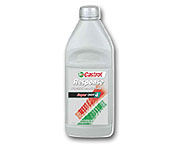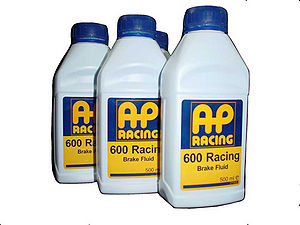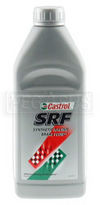Difference between revisions of "Brake fluid"
m |
|||
| Line 53: | Line 53: | ||
| − | + | [[How to change the brake fluid]] | |
| − | |||
| − | |||
{{clr}} | {{clr}} | ||
[[Category:Brakes]] | [[Category:Brakes]] | ||
Revision as of 12:48, 11 January 2007
Lotus specify Castrol Super DOT 4 brake fluid changed annually. This is a fully synthetic brake fluid that exceeds the boiling point specifications of most DOT 5.1 fluids and is no more costly and for road use this is fine.
Hard track use with extended high temperatures over 30 minute sessions needs some further consideration; regular change of less expensive fluid or more expensive race fluid changed less ? There is no right answer.
The function of brake fluid is to provide an incompressible medium to transmit the driver’s foot pressure to clamp the friction material against the discs. When fresh, all brake fluids are virtually incompressible, but overheated brake fluid will boil in the calliper producing gas bubbles which are compressible leading to a “soft” brake pedal with long travel.
The dry boiling point is the temperature at which a given brake fluid boils when it is fresh out of the can. Since DOT 4, and DOT 5.1 brake fluids are hygroscopic and adsorb water over time (through the breathers, calliper piston seals and by magic) which boils at 100 °C, the absorbed water dramatically lowers the boiling point of the brake fluid. The Wet boiling point is the temperature at which a given brake fluid boils when it has taken on 3.7% H2O. For detailed discussion checkout http://www.stoptech.com/tech_info/wp_brakefluid_1a.shtml
Notes from a 40 track hour a year Elise;
• Comma DOT5.1 £8/lit (Dry 280°C Wet 180°C). Is this as good as the Super DOT4 ?
• Castrol Response Super DOT 4 £10/lit (Dry 280°C Wet 186°C). This was needing to be changed every 6 track hours with a gradually softening pedal, coming out black from the front callipers and discoloured from the rear.
• AP600 £20/lit (Dry 310°C Wet 210°C). This seems to want 50ml bled off the front callipers every 6 track hours (no noticeable colour change) which will effectively purge the system every year (but don't forget to do the rears and clutch).
• Castrol SRF £50/lit (Dry 310/Wet 270°C) This is in a class by itself with patented chemistry providing wet boiling point close to most other fluids dry. Not affluent enough to try this.
Brake bleeding (quick)
Order; OSR, NSR, OSF, NSF. Wheels off for the rears, but can do it through the spokes at the front. For each calliper in turn, pump the brake pedal until it is solid then maintain the pressure whilst the other person puts a non return value on the brake nipple and releases it (11 mm spanner) until the pedal hits the deck.
Brake bleeding (long - wheels and callipers off)
• Tap on the callipers and hoses gently with a plastic hammer to dislodge any bubbles that adhere to the surface
• Get some (very)worn brake pads. Fit these to the front callipers and press the pedal a few times to extend the pistons. This will fill them up with fluid.
• Now put the pressure bleeder on the reservoir and put some light pressure on it. Not too much or you can pop the pistons out in the next step.
• Remove a front calliper, invert it open the bleed nipple and tape the brake hoses gently and also tap on the inside of the calliper.
• Then (with your hands) squeeze the INNER piston in. This will empty the inner piston and force the bubbles to the front one. Make sure you push it completely in.
• Now carefully rotate the piston normal side up again. Try to turn it so any bubbles in the outer piston will not try to go up the connecting pipe again.
• Now tap the calliper again and squeeze the OUTER piston back into the calliper. Once it's fully in, close the bleed nipple and do the other side.
• You should get some extra bubbles out.
• For the rear brakes make sure you screw the pistons completely back into the calliper before you bleed them.
Don't skimp on the amount of fluid. Get 2L and work your way through it.


